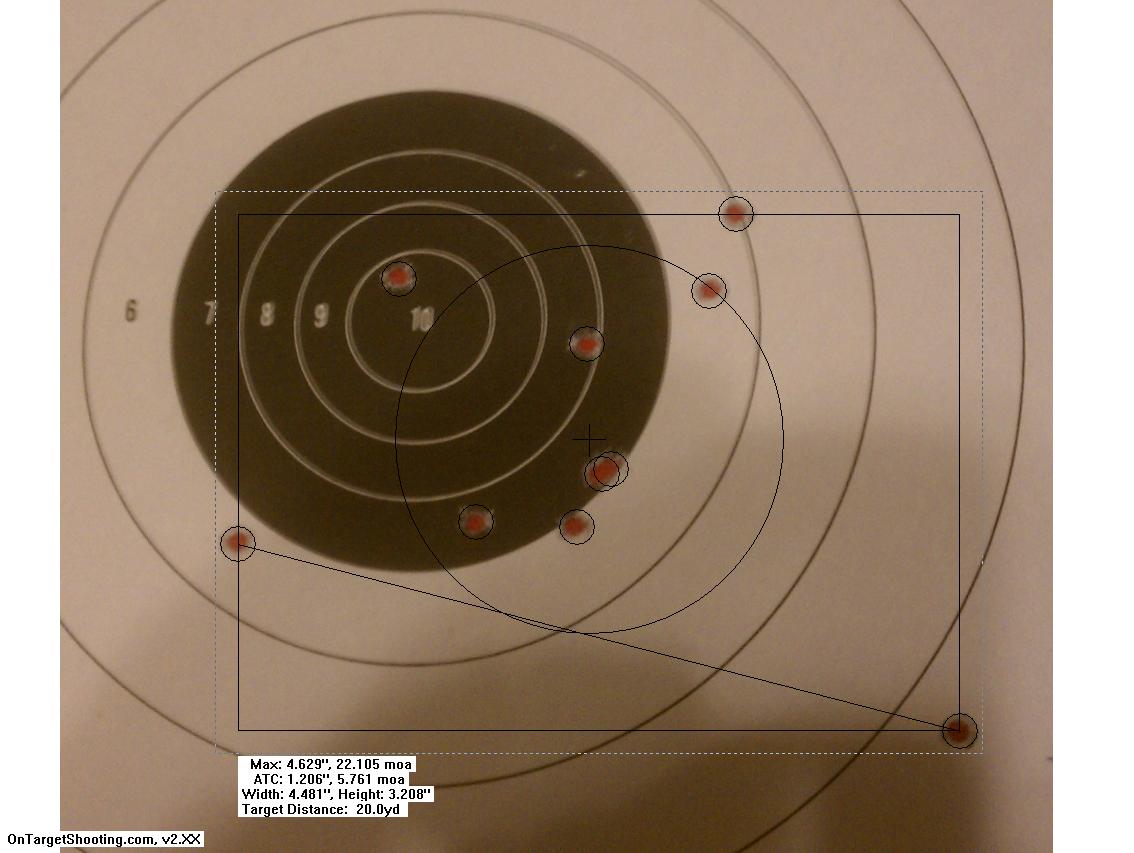Used three different types of ammo; some old stuff that my buddy's father had from like 1970 that surprisingly still worked, CCI subsonic hollow points, and my favorite 'cheap' ammo, CCI standard velocity. The gun had a few failures to fire on the old ammo; a primer strike was evident. We also encountered a number of failures to feed the first round of the magazine, and later during the session we started to encounter a lot of 'stove-pipe' jams; failure to fully eject.
On to the scores.
slow fire: 63, 58, 48, 52, 45, 45. avg. 51.83
rapid fire: 57, 57, 49, 62. avg. 56.25
est. match score: 164.33
That is a bit of a decline from my previous scores. My slow-fire average was exactly the same, while my rapid fire was down about 6 points. We encountered more of our jams (alibi's) in rapid fire, so that might explain some of the difference. I also felt like I was having a hard time getting my timing right in rapid fire. My slow fire felt really good, although I thought I would have shot a little better.
SBGST
Stance: continues to feel more and more comfortable and easy to find. I close my eyes and bring my arm up to the target and then adjust. I've been experimenting with how much I face the target, but have been trying to keep my body less exposed to the target and more of a 'duelist' stance, trying to line up the majority of my body behind the gun. I've noticed that all of the ISSF guys seem to shoot almost completely sideways with their feet parallel to the target. I've been standing with my right foot pointed towards the target and my left parallel. The pointed toe is probably a result of my injury to my right leg that I'm still recovering from. I may try the double parallel stance this week and stand more sideways and see how well that works out. My natural tendency is to open up my stance and put my body more facing the target.
Breathing: I was focusing more on my breathing during the slow-fire shots and establishing a good rhythm. After a shot, I would exhale as I lowered the gun. I would then rest the gun on the bench to take pressure off my arm while taking in a deep and slow inhale followed by a slow exhale, sometimes closing my eyes. The next inhale I used to raise the gun. At the stop of the inhale, the gun was on target and I started to wait for the sights to settle as I started a slow exhale.
Grip: Definitely improving. I felt like I was taking a consistent grip on the gun and didn't find myself adjusting much. I have increased my grip tension considerably. I tighten until the gun starts to shake, then I relax until its stable. This results in a pretty tight hold. I think this helped my recovery times between shots in rapid fire, but the scores don't totally reflect that.
Sights: Still having a bit of trouble focusing on the front sight against the black bull. It would be really nice to be able to put some fibre sights or dot sights on the Ruger. Maybe I will try a little white nail polish on the front sight and see if that helps. I also found myself drifting my sight picture relative to the target during rapid fire, which was difficult to stay focused on the front sights when I could see the target moving in the background.
Trigger: I'm using a technique similar to one that Brian Zins advocates which is using the first joint of the finger on the trigger as opposed to the more popular method of using the pad of the finger on the trigger. Zins likes using the joint because its more solid and has less 'give' than the pad of the finger, which is compressible. He feels that the compressibility of the pad of the finger gives him less feel over the trigger pull and break. He also says something interesting in that the firing of the gun is not a 'surprise' to him when the trigger breaks. Everyone tends to say that the trigger break should feel like a surprise, but Zins simply says that he knows when the trigger is going to break. That makes sense given his level of experience (10-time NRA pistol champ, runner-up in Top Shot Season 2). I still need to focus on the surprise break to avoid recoil anticipation and/or pulling the shot. My next session I am going to focus a lot more on the trigger. I noticed a number of my shots tending to group on the right, and according to the trigger rose, that's indicative of using too much trigger finger, so I'm probably not pulling straight backwards as I should be.
Here are two of my slow-fire targets with groupings:


No comments:
Post a Comment